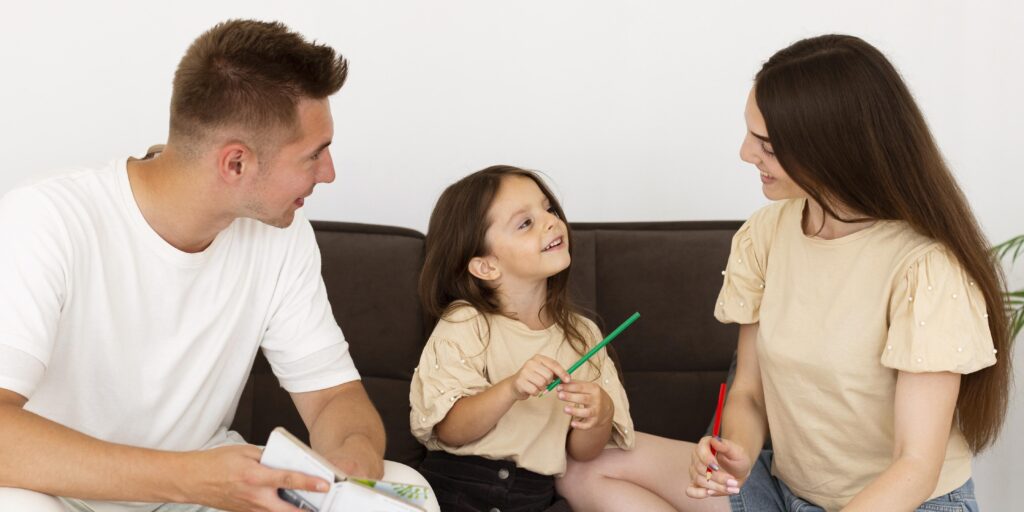Every year on May 15, we celebrate the International Day of Families — a day dedicated to recognizing the importance of families in shaping societies. But if you’re a parent or caregiver, you know that this day isn’t just symbolic. It reflects a daily reality: the role of family in child development is not just important — it’s everything. Families are the foundation of a child’s life, shaping their values, behavior, and emotional well-being from the very start.
In today’s fast-paced world, it’s easy to overlook how everyday family interactions influence a child’s growth. This blog combines my personal journey as a mother with insights from research to highlight the powerful impact of family support on building trust, confidence, and healthy habits in young children. From managing screen time thoughtfully to modeling positive behavior and using clear, loving communication, these simple but meaningful actions create a strong foundation for lifelong resilience.
If you want to understand the importance of family in raising children and discover practical ways to nurture a positive family environment, keep reading. Together, we’ll explore how family influence can help children thrive emotionally, mentally, and physically.
Family’s Role in Emotional Security
The role of family in child development isn’t just a theory written in research papers — it’s something I’ve lived every single day. From the very beginning, I noticed how my child looked for comfort in my voice, my expressions, my presence. Whether he was hurt or just upset, he’d instinctively come into my arms — because that’s where he felt safe, seen, and understood.
And that’s not just an emotional moment — it’s neuroscience. When children consistently experience love, regulation, and connection at home, their brains develop stronger emotional and social wiring. Research backs this up: emotionally secure children show better problem-solving skills, higher confidence, and healthier relationships as they grow.
One thing I learned is that yelling never works. If I try to explain something gently — even if he doesn’t fully agree — he listens. But the same thing, if said in anger, triggers resistance and stubbornness. That’s when I realized: it’s not about making children obey, it’s about helping them feel heard. And when they feel heard, they listen better.
In our home, we practice this daily — not just in deep conversations but in everyday routines. Whether we’re eating together or folding laundry, I try to engage him in ways that build connection. I don’t believe screen time — no matter how “educational” — can replace this. Movement, eye contact, and presence matter. That’s how children grow — emotionally, mentally, and physically.
The importance of family in childhood isn’t just about protection or discipline. It’s about presence. It’s about showing up every day — not perfectly, but intentionally.
Role of Family Shapes Social Skills and Confidence
The role of family in child development goes beyond basic care—it’s where children first learn how to connect, communicate, and express themselves confidently. When children feel secure and supported at home, their social skills naturally flourish. This foundation helps them adapt smoothly to school environments and build meaningful friendships.
Studies confirm that children from warm, responsive families develop stronger social skills and greater emotional resilience. These early experiences teach children how to navigate relationships, cooperate with others, and manage conflicts — all essential life skills.

Everyday family interactions, like sharing meals or calmly resolving disagreements, play a crucial part in building respect, empathy, and cooperation. These moments strengthen the child’s ability to engage positively with the world outside the family.
As the saying goes, “It takes a whole village to raise a child.” This reminds us that the family’s role is central in providing the tools children need to succeed socially and emotionally.
By nurturing a loving and positive home environment, the family’s influence on child development equips children to thrive not only within the family circle but throughout their lives.
Balancing Screen Time and Family Interaction
In today’s digital age, managing screen time has become one of the biggest challenges for families. The role of family in child development now includes finding a healthy balance between technology use and meaningful face-to-face interactions. Screens can be educational and entertaining, but they should never replace the warmth and connection that only family presence can provide.
Children learn best through real-life experiences — watching, listening, and engaging with those around them. When screens take up too much time, kids miss out on crucial moments of eye contact, touch, and conversation that build emotional security and social skills. Too much screen time also affects physical health, leading to less movement, poor posture, and disrupted sleep patterns — all of which can impact a child’s overall growth and well-being.

That’s why families who actively set boundaries and prioritize quality time together help children develop stronger communication, emotional regulation, physical health and perform better academically. It’s not about banning devices completely but about making mindful choices. For example, scheduling “screen-free” family moments during meals or playtime encourages children to be fully present and connected. Parents can also use screen time as an opportunity for shared experiences — like watching an educational program together and discussing it afterward.
Children spell love T-I-M-E.
-Dr Anthony P Witham
I’ve seen how balancing screen time with family interaction makes a huge difference. When we put phones aside and focus on each other, even simple activities like cooking or walking become chances to bond and teach important life lessons. This creates a positive environment where children feel valued and understood, strengthening their confidence, resilience, and physical health.
Remember, the role of family in child development is to create a nurturing space where children can grow emotionally, socially, and physically—and that can only happen when technology complements—not replaces—family connection.
Family Behavior Shapes Children
Children don’t just listen to what we say — they watch what we do. That’s why the role of family in child development includes being a living example of the values and behaviors we want our children to adopt. Whether it’s how we speak to others, manage stress, or express emotions, our everyday actions become powerful lessons.
There were moments when I raised my voice out of frustration — it happens to every parent. But what mattered most was what came after. I began to acknowledge those moments instead of brushing them aside. Saying “I was wrong to yell” or “I’ll try to do better next time” not only helped me grow, but it also taught my child an important lesson: making mistakes is human, but taking responsibility builds character.
Children learn these things by observing how we handle our own imperfections. When they see us admit mistakes, apologize sincerely, and try again with intention, they learn resilience, empathy, and self-control.
Even small daily actions — like saying thank you, managing stress calmly, or resolving disagreements with respect — shape their understanding of how to behave in the world. The home becomes their first classroom, and we, their most influential teachers.
By modeling positive behavior, we’re not just raising well-behaved children — we’re raising emotionally intelligent, grounded individuals ready to face life with kindness and confidence.
Role of Family Communication in Building Connections
In the chaos of parenting, we often forget the power of simple, intentional communication. But the truth is, the importance of family in raising children shows up most in how we speak to them — especially during the tough moments. A calm tone, eye contact, and honest, kind words can turn even everyday interactions into opportunities for connection.

It’s not always easy. There are days when emotions run high, routines break down, or patience runs thin. But I’ve noticed something — when I shift from reacting to responding, everything changes. Instead of snapping back or correcting with frustration, I pause, breathe, and speak with understanding. This not only helps my child listen, but also teaches him how to respond to challenges with self-control.
What we say — and how we say it — becomes their inner voice.
Children who grow up in families where communication is open, respectful, and loving tend to have higher self-esteem and stronger emotional regulation. Even when discipline is needed, explaining the ‘why’ behind a boundary fosters trust instead of fear. And when children feel safe to express themselves, they’re more likely to seek guidance, share struggles, and make better choices.
For more helpful advice on positive parenting, visit our Positive Parenting blog.
Final Thoughts: The Lasting Impact of Family’s Role on Child Development
The role of family in child development isn’t limited to big life lessons — it’s in the little things, repeated every day. From calm communication and shared routines to balancing screen time and encouraging emotional growth, these moments shape how children view the world and themselves.

It’s not about being perfect parents or caregivers. Mistakes happen — we all have moments we wish we’d handled differently. But what matters most is showing up, learning, and growing with our children. Apologizing when we fall short. Trying again. Choosing connection over control. That’s where the real strength of a family lies.
Let’s not underestimate our everyday presence. Because in a world full of distractions, family is the first place where children learn to feel safe, seen, and supported. And when those roots are strong, they carry that sense of security into every part of life — emotionally, mentally, and physically.
Let’s keep choosing to give them that time — with love, patience, and purpose.
References
- American Academy of Pediatrics. (2016). Media and Children Communication Toolkit. Retrieved from https://www.aap.org/en/patient-care/media-and-children/
- Center on the Developing Child at Harvard University. (2017). Serve and Return Interaction Shapes Brain Circuitry. Retrieved from https://developingchild.harvard.edu/resources/serve-and-return/
- Baumrind, D. (1967). Child Care Practices Anteceding Three Patterns of Preschool Behavior. Genetic Psychology Monographs, 75, 43-88.
- Witham, A. P. (n.d.). Quote: “Children spell love T-I-M-E.”



